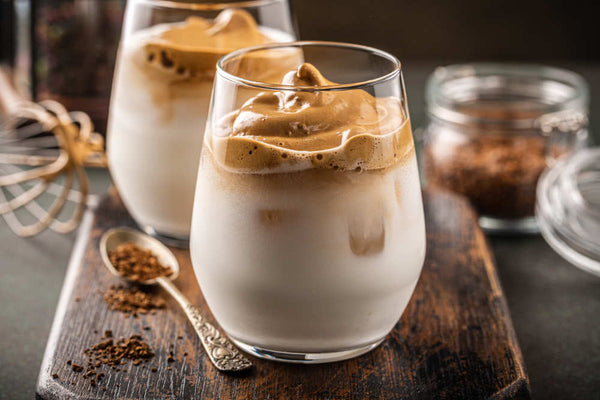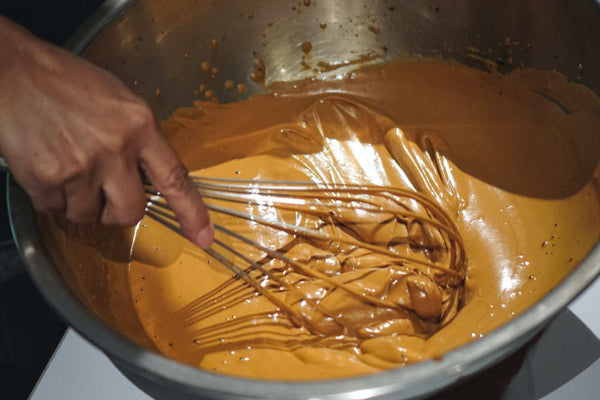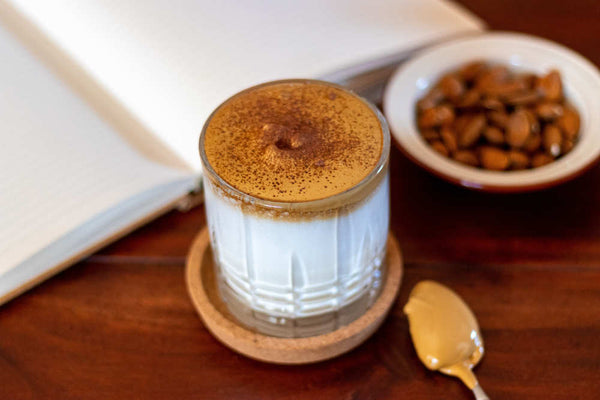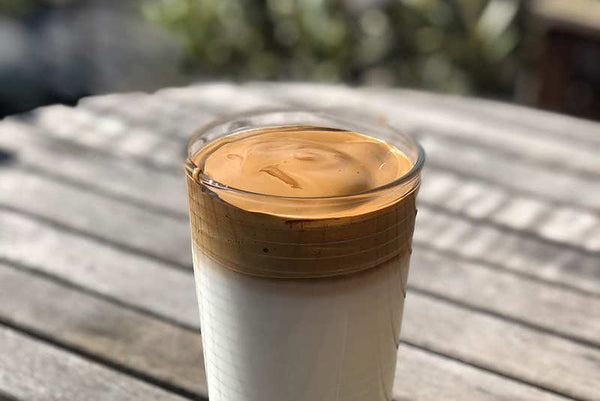Korean whipped coffee, known as Dalgona coffee, has taken the world by storm. According to Google Trends statistics, Dalgona coffee has become the most popular coffee in the world based on search queries. In March 2020, the interest in Dalgona coffee reached a score of 100, indicating the highest level of popularity for the search term.
Dalgona coffee's rise to fame during the quarantine period was not a coincidence. This beverage is easy to prepare and looks as though it was ordered from a café. However, Dalgona coffee's acclaim is not due to its taste, as it has an indirect relationship with coffee.
Let us delve into the history of Dalgona coffee's emergence and explore the recipe for preparing this beverage.
What is Dalgona coffee?
Dalgona coffee is a Korean "whipped" beverage made from instant coffee, sugar, and hot water in a 1:1:1 ratio. The ingredients are whipped into a foam, which is then placed on top of milk with ice. The result is a beautiful and extremely sweet dessert with a hint of milk flavor, where the coffee is barely noticeable.

Dalgona coffee is undeniably a photogenic dessert, but it is not truly a coffee beverage.
Where did Dalgona coffee originate from?
"Whipped coffee" is prepared in China and Pakistan, where it is known as Macau Coffee. When Korean actor Jung Il-woo tried this beverage on a TV show, he compared it to Korean street sweets called Dalgona.
Dalgona candies are made from sugar and baking soda. The sugar is melted into caramel, then a pinch of baking soda is added, the ingredients are mixed, and the mixture is allowed to solidify. Dalgona coffee truly resembles these candies in appearance and taste, which is how it acquired its name.
India Today notes that Dalgona coffee is simply an analogue of Phenti Hui Coffee or Beaten Coffee, a beverage that has long been prepared in India. The only difference is that in Phenti Hui, milk is poured over the main mixture, whereas in Dalgona coffee, milk is poured first, followed by the creamy foam on top.
The popularity of Dalgona coffee began to soar after users on social media started sharing videos of its preparation. A TikTok video posted by a user named Hannah garnered two million likes, and the hashtag #dalgonacoffee received 341.5 million views.
According to the Los Angeles Times, the Dalgona coffee trend on social media can rival the popularity of latte art.
People are sharing aesthetic and even comedic videos of Dalgona coffee preparation. Over time, different variations of the beverage have emerged, such as Matcha Dalgona, Latte Dalgona, and Milk Tea Dalgona.So, Dalgona is a trendy beverage, but not a coffee-based one. It will appeal to those who enjoy creating beautiful photos for social media and indulging in sweet milk-based cocktails, but not to those who appreciate specialty coffee.
How to make TikTok coffee
What role does coffee play in Dalgona, and how does it affect the taste of the beverage? Let's delve into it together with James Hoffmann, the 2007 World Barista Champion, author of the book "The World Atlas of Coffee: From Beans to Brewing," and co-founder of London-based roastery "Square Mile Coffee Roasters."
Exploring Dalgona coffee with James Hoffmann
To prepare classic Dalgona coffee, you will need a whisk or mixer, as well as the following ingredients:
- 2 tablespoons of instant coffee
- 2 tablespoons of sugar
- 2 tablespoons of hot water
- 300 ml of milk (equivalent to 17 tablespoons)
- 3-5 ice cubes
Let's break down the process step by step:
1:50-3:00
Mix two tablespoons of instant coffee, two tablespoons of sugar, and two tablespoons of hot water. James Hoffmann decided to measure the weight of the ingredients for the correct ratio. It turned out to be 6 grams of coffee, 21 grams of sugar, and 20 grams of water. Whisk the mixture until it forms a creamy foam. Hoffmann spent 3-4 minutes doing this.
8:17-8:50
You can replace the whisk with a mixer or blender. This won't affect the taste of Dalgona coffee; it simply makes it easier to achieve a foamy texture.

3:32-5:40
So, you've created a beautiful, soft foam. Now let's understand how this texture is achieved. James Hoffmann explains:
"The first time I saw the foam of Dalgona coffee, I thought it resembled meringue. In meringue, egg whites create the foam, and sugar stabilizes it. In Dalgona, coffee acts as the foaming agent.

According to research, during coffee roasting, a group of compounds called melanoidins is formed. They create a stable foam. I suspect that Dalgona has similar foaming agents. These surfactant substances are commonly referred to as surfactants. They "wrap around" air bubbles and make them "strong." For example, in cappuccino milk, proteins serve as surfactants.
The presence of a certain amount of surfactants in coffee does not contribute to achieving a perfectly stable foam. Note that the crema on your espresso bubbles and disappears within one or two minutes.
So, how does Dalgona coffee achieve a dense and stable foam? It becomes viscous due to its composition: equal parts sugar and water, essentially creating a syrup. We add 6 grams of instant coffee to the mixture, resulting in a thick, sticky liquid. When whisked, it forms small bubbles, creating a very dense and stable foam."
5:41-6:14
Now take a cup with ice cubes and pour milk into it. The milk can be any type—cow's milk, coconut milk, almond milk, oat milk. Then, place our creamy foam on top. Due to its texture, it will float on the surface of the beverage. Dalgona coffee is ready!

"Coffee" foam floating on the surface of the beverage. © foter.com
6:17-8:17
James Hoffmann describes the taste of the prepared beverage as a typical sweet instant coffee with milk. Regardless of how beautiful and velvety its foam may be, it does not create a distinct aroma or flavor.
Can you make specialty Dalgona coffee?
James Hoffmann does not recommend substituting instant coffee with espresso in Dalgona coffee. When preparing espresso, you cannot achieve the same concentration of dissolved substances in water as when diluting two tablespoons of instant coffee with two tablespoons of water. You can heat the espresso to evaporate excess water and obtain a more viscous liquid, but this cannot be done at home without a vacuum chamber. In any case, Dalgona made with espresso would result in a "terrible-tasting beverage."
9:50-11:15
In an attempt to improve the taste of Dalgona coffee, James Hoffmann tried using specialty instant coffee and slightly adjusting the proportions: 3 grams of coffee, 10 grams of sugar, 10 grams of water. However, a good, dense foam was not achieved. James Hoffmann added more sugar, but it didn't help; the liquid still did not foam properly. So, he decided to cool the mixture in the freezer, and it worked. The colder the foam, the more viscous and dense it becomes.
11:43-12:26
So, according to James Hoffmann's recipe, "specialty Dalgona" tastes like coffee ice cream. It lacks the bitterness—an unpleasant attribute of instant coffee. However, it is still very sweet, so the predominant flavor in the beverage is sugar rather than coffee.
According to James Hoffmann, it is worth making Dalgona coffee if:
- You have instant coffee at home that you haven't found a use for.
- You want to prepare something interesting.
For James Hoffmann, Dalgona coffee is not a coffee beverage; it is a playful indulgence with the taste of coffee syrup. Yes, it is easy to make, requiring no special equipment or expensive ingredients. However, these advantages are unlikely to outweigh the taste experience. What are your thoughts on this TikTok coffee trend?

